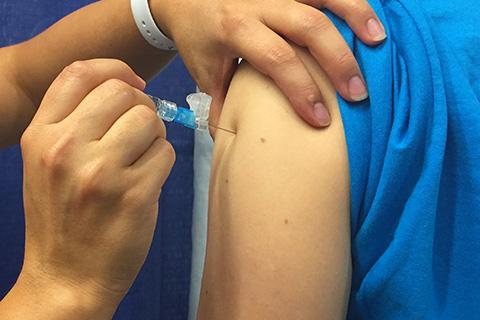We’ve seen the return of many things, good and bad, as society has reopened and life has found the so-called new normal. One of those things this year is the flu—and it’s back with a vengeance.
After an unusual, two-wave yet mild season in 2021–2022 and an even milder 2020–2021 season, the flu is now sweeping across the U.S.
Thankfully, it isn’t too late to get vaccinated, and it’s easy for employees at NCI Frederick and Frederick National Laboratory to do so. Occupational Health Services (OHS) still has plenty of vaccine doses available and is still hosting vaccine clinics.
Clinic Is Open
The clinic on the NCI Frederick campus is open in the OHS lobby in Building 426 between 12:30 p.m. and 3 p.m. on Mondays, Wednesdays, and Fridays. For staff at the Advanced Technology Research Facility, the clinic is in the OHS suite (near the Protective Services desk) on Mondays and Thursdays from 12:30 p.m. to 3 p.m.
Off-site employees can travel to either location to be vaccinated.
Staff must bring a completed consent form with them to the clinic. OHS has also asked employees over age 65 to call or email in advance to reserve a high-dose vaccine.
The vaccine formulation contains no egg protein or antibiotics, nor do the pre-filled syringes contain latex. In addition, the manufacturing process used a cell-based, egg-free method.
The Time Is Now
This is indisputably an important time to roll up a sleeve for vaccination.
“Dramatic” is overused in the health sciences, but it’s an apt description for how this year’s flu season is shaping up. The Centers for Disease Control and Prevention (CDC) reports that the rate of flu-related hospitalizations is swiftly rising. It’s already as high as it was during late December and early January in pre-pandemic years.
Meanwhile, the rate of reported influenza-like illnesses—flu symptoms that haven’t been confirmed by laboratory test to be the flu—has soared. Eleven states, including nearby Virginia, have reached the CDC’s highest classification. Maryland isn’t far behind, while West Virginia and Pennsylvania are trending between moderate and high rates. Nationwide, the rate this week is higher than the same week in any past year for which the CDC has made data available.
Add to that the health care burden from other circulating pathogens. SARS-CoV-2 remains a nagging presence, and with new immunity-dodging variants on the rise, models project that infections will increase this winter. Respiratory syncytial virus cases remain unusually high, as well. With the medical field already burdened, fatigued, and understaffed, a sharp rise in flu cases adds yet another straw to the weary camel’s back.
Vaccine and Virus Align
There’s good news, though. This season’s flu vaccines seem to be on target to protect against the circulating strains.
Many of the vaccines are quadrivalent, encompassing four viral lineages. The one offered by OHS—like many others this year—covers an H1N1 strain, an H3N2 strain, a B/Victoria strain, and a B/Yamagata strain.
Reports so far indicate H1N1, H3N2, and B/Victoria lineages are driving infections this year, with H3N2 as the most common. Laboratory models at the CDC suggest that antibodies generated in response to the vaccine can recognize this season’s circulating strains.
Given that the vaccine doesn’t always align with the strains that end up circulating, the match is encouraging. It means the models, analyses, and effort that went into selecting the strains for this year’s vaccine anticipated the strains that emerged.
But it’s also important not to delay getting vaccinated, since it takes two to four weeks after vaccination for protective antibodies to reach their peak levels. With the holiday season here and the virus rapidly spreading, that doesn’t leave much time.
It also isn’t worth waiting in hopes of getting an mRNA flu vaccine this year. Although recent months have witnessed several reports and announcements about such vaccines making progress, they’re still in clinical trials and likely won’t be available in time for this season.
OHS will continue to offer a flu vaccine throughout winter. If the clinics close, employees can contact the OHS staff to arrange a vaccination appointment.
Samuel Lopez leads the editorial team in Scientific Publications, Graphics & Media (SPGM). He writes for newsletters; informally serves as an institutional historian; and edits scientific manuscripts, corporate documents, and a slew of other written media. SPGM is the creative services department and hub for editing, illustration, graphic design, formatting, multimedia, and training in these areas.


